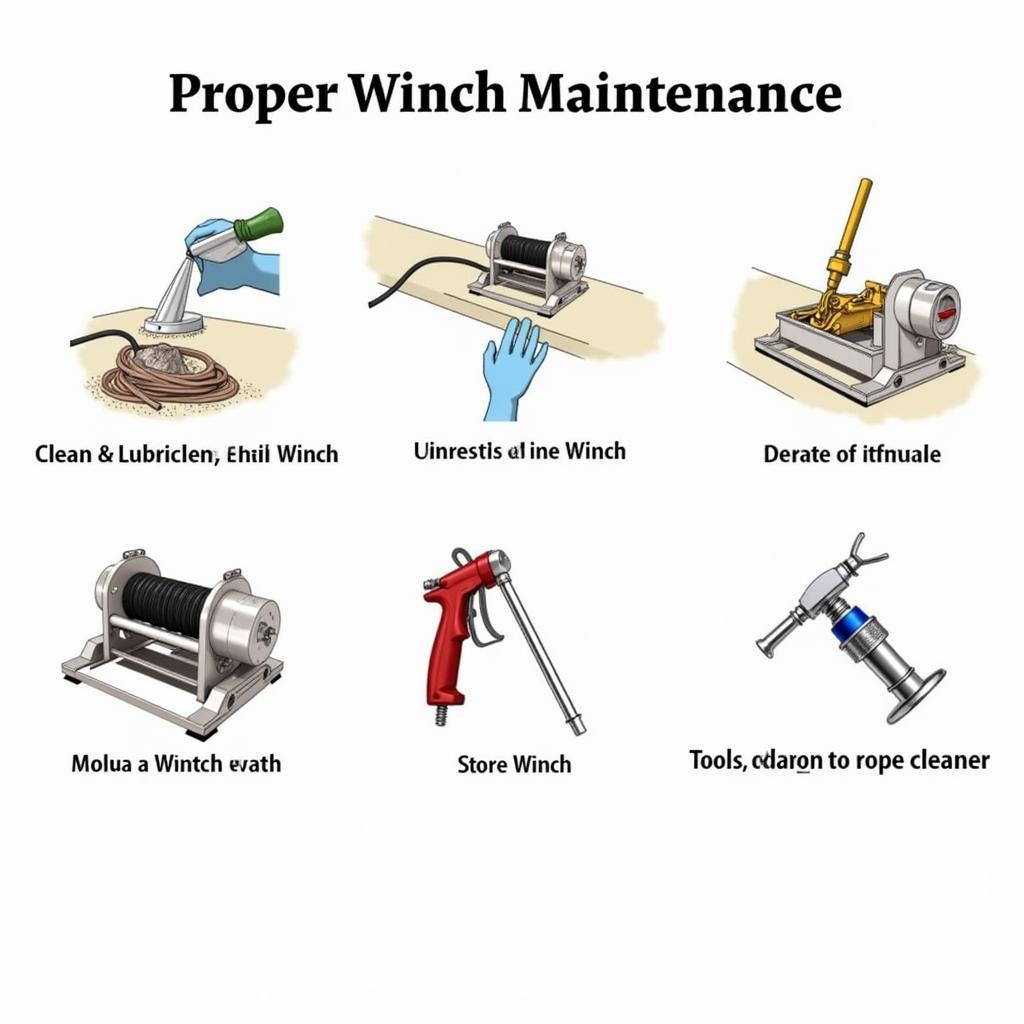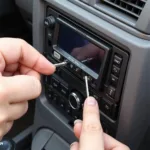A winch tool for car is an essential piece of equipment for anyone venturing off-road or driving in challenging conditions. Whether you’re stuck in mud, snow, or sand, a winch can be a lifesaver, providing the pulling power needed to get your vehicle back on solid ground. This comprehensive guide will cover everything you need to know about winches, from choosing the right one to safe operation and maintenance. tools to get car out of snow
Understanding Winch Types and Their Applications
Winches come in various types, each designed for specific applications. The most common types include electric winches, hydraulic winches, and hand winches. Electric winches are popular for their ease of use and versatility, powered by your vehicle’s battery. Hydraulic winches, on the other hand, offer superior pulling power and are often found on heavy-duty recovery vehicles. Hand winches are more portable and affordable but require significant manual effort. Choosing the right winch type depends on factors like your vehicle’s weight, the terrain you typically drive on, and your budget.
How to Choose the Right Winch Tool for Car
Selecting the right winch tool for car involves several crucial considerations. First, determine your vehicle’s gross vehicle weight rating (GVWR), which includes the weight of the vehicle, passengers, and cargo. Your winch should have a pulling capacity at least 1.5 times your GVWR. Second, consider the type of terrain you frequently encounter. For muddy or snowy conditions, a winch with a higher speed might be preferable. For rocky terrain, a winch with a lower speed and higher pulling power is recommended.
Key Factors to Consider When Buying a Winch
When purchasing a winch, look for features like a robust motor, a durable drum, and a reliable braking system. A weather-sealed housing is essential for protecting the winch from the elements. Also, consider the length and diameter of the winch rope. A longer rope provides more flexibility, while a thicker rope offers greater strength.
Safe Winching Techniques and Best Practices
Safe winch operation is paramount to prevent accidents and damage. Always inspect your winch and equipment before each use. Ensure the winch is securely mounted and the rope is properly spooled. When winching, use gloves and eye protection. Never stand directly in line with the winch rope. Use a damper or blanket over the winch rope to reduce the risk of injury in case of rope breakage.
Essential Safety Precautions for Winching
- Always use a tree saver strap: This protects trees from damage during winching operations.
- Use proper anchor points: Choose sturdy anchor points, such as trees or rocks, to ensure a secure connection.
- Never overload the winch: Exceeding the winch’s rated capacity can lead to damage or failure.
- Communicate clearly with your spotter: Use hand signals or a two-way radio to coordinate the winching process.
“A common mistake people make is underestimating the importance of proper winching techniques,” says John Smith, a certified off-road driving instructor. “Following safety guidelines and using the right equipment is crucial for preventing accidents and ensuring a successful recovery.”
Winch Maintenance and Care
Regular maintenance is essential to keep your winch in optimal working condition. After each use, clean the winch and rope to remove mud, dirt, and debris. Inspect the rope for fraying or damage. Lubricate the moving parts of the winch regularly. Store the winch in a dry and protected location.
 Winch Maintenance Tips
Winch Maintenance Tips
“Preventive maintenance is key to extending the lifespan of your winch,” adds Sarah Jones, a seasoned off-road enthusiast. “Regular cleaning and lubrication can prevent corrosion and ensure reliable performance.”
car tools for a liberty spot jeep
Conclusion: Mastering the Art of Winching
A winch tool for car is an indispensable tool for off-road adventures and emergency situations. Choosing the right winch, understanding safe operating procedures, and performing regular maintenance are essential for maximizing its effectiveness and longevity. With the knowledge and skills you’ve gained from this guide, you’re well-equipped to confidently handle any recovery situation. Remember, a winch is not just a tool; it’s an investment in your safety and peace of mind.
FAQs
- What is the best type of winch for a beginner?
- How often should I service my winch?
- What are the common signs of a failing winch?
- How do I choose the right winch rope length?
- What are the essential accessories for winching?
- How can I prevent my winch rope from tangling?
- What are the safety precautions to take when using a winch alone?
Common Winching Scenarios
- Vehicle stuck in mud: Use a snatch block for increased pulling power if necessary.
- Vehicle stuck in snow: Clear the area around the tires and use traction mats for added grip.
- Vehicle stuck on a hill: Use a come-along winch for added safety and control.
Further Reading
For more information on off-road recovery and vehicle maintenance, check out our other helpful articles: tools to get car unstuck, emergency car tool set
Need assistance? Contact us via WhatsApp: +1(641)206-8880, Email: cardiagtechworkshop@gmail.com, or visit us at 910 Cedar Lane, Chicago, IL 60605, USA. Our customer support team is available 24/7.

